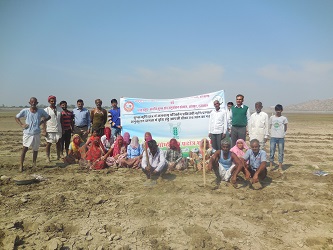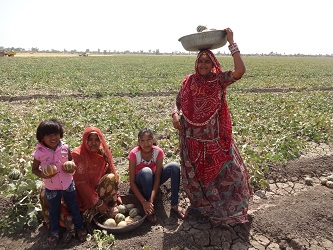The resource-poor farming communities are almost exclusively dependent on the autonomous adaptations to cope with the multiple stressors impacting their livelihoods. Nonetheless, such adaptive practices often fail to deliver the intended benefits beyond a threshold; necessitating their integration with Institutional knowledge for sustained outcomes. The farmer participatory research sought to equip the farming communities of Pali, Rajasthan with a set of improved practices to enable them to adapt to the prevailing risks. The Pali District has an arid climate with average annual precipitation of ~300 mm and open-wells are the main source of irrigation water. The collaborative research between the ICAR-Central Soil Salinity Research Institute, Karnal, Haryana and Krishi Vigyan Kendra, Pali, Rajasthan was carried out during 2017-2019 in 6 purposively selected Villages - Hemawas, Sonai-Majee, Mandali, Manpura, Bhakri, Guda-Narkhan and Ateli involving 30 Farmers (5 from each Village).
The Study farmers conventionally grow Muskmelon in the heavy-textured, saline soils located in the Hemawas Dam Catchment.


Autonomous practices
The farmer participants had a poor economic status and limited access to improved technologies. A strong majority (˃84.0%) of them were faced with the multiple risks, viz., poor adaptive capacity, climate variability (delayed onset of Monsoon and erratic rainfall) and high salinity in soil (EC2= 0.85-1.58 dS/m, mean 1.27 dS/m) & irrigation water (ECiw= 0.56-1.78 dS/m, mean 1.37 dS/m). They have evolved a Muskmelon-based autonomous adaptive practice to safeguard their livelihoods. In this practice, the farmers pool their knowledge and resources (Open-well water, seeds and labour) to grow locally adapted Muskmelon (vars. Chandra, Madhu and Kajari), Mustard and Wheat Crops by harnessing the residual moisture.
The Muskmelon Seeds are manually sown in the well-prepared fields during the last week of February in the low catchment areas. Before sowing, the seeds are immersed in lukewarm water followed by overnight wrapping in the moist Jute bags. The fields are planked after 2 to 3 weeks to improve water availability and to suppress insect-pest infestations. The Muskmelon Crop duration (March to May) is usually the lean period, enabling them to devote a greater focus on raising a profitable crop.
Institutional knowledge improves the outcomes
Although this opportunistic adaptation has undoubtedly ensured better profits and improved livelihoods, the emerging social-ecological risks like climate variability, increase in salinity, some gender-specific issues and restricted access to the Institutional knowledge have considerably reduced the profits from Muskmelon cultivation; the study farmers perceived. In this backdrop, the Institutional interventions included the distribution of Soil Health Cards, Agro-advisories for managing the salinity risk (Conjunctive use of irrigation water), improving soil water availability, technical help for de-silting & recharge of open-wells, supply of seeds of variety - Kajari and improving the existing market linkages.
Productivity and Income Generated from Muskmelon (Variety Kajari) by the Farmers
| Year | Productivity (t/ha) | Increase (%) |
Net Income (Rs/ha) |
Increase (%) |
B: C ratio |
|---|---|---|---|---|---|
| 2016* | 47.8 | - | 38,475 | - | 2.77 |
| 2017** | 59.7 | 24.89 | 42,450 | 10.33 | 3.45 |
| 2018** | 62.0 | 29.70 | 46,560 | 21.01 | 3.89 |
| 2019** | 64.5 | 34.93 | 52,400 | 36.19 | 4.10 |
| Average (2017-2019) | 62.0 | 29.70 | 47,137 | 22.51 | 3.81 |
* Before intervention year; ** After the intervention year
Before the interventions, the farmers only applied farm yard manure as a source of nutrients alongside dusting ash on mature plants. However, after the advisories, they also started applying potassium to increase the fruit quality and reduce the negative effects of salt and water stresses on vine growth. The intervention, besides increasing the shelf-life of fruits, also improved the plant tolerance to insect-pests and climatic stresses, the study farmers perceived.
- The interventions had a clear positive effect in reducing the various risks and improving the crop productivity.
- There was a considerable increase in the productivity (47.8 to 64.5 Q/ha) and B: C ratio over the study period (2017-2019). The improvements in productivity over the base Year (2016) were 24.89%, 29.70% and 34.93% in 2017, 2018 and 2019, respectively.
- Earlier, the farmers sold Muskmelon to the local markets at wholesale prices of Rs. 5 to Rs. 7 per Kg. However, the efforts enabled them to sale Muskmelons to the distant markets (through networking) at much higher prices (Rs. 15 to Rs. 17 per Kg).
- Clearly, the interventions not only helped the farmers to address the aforementioned problems to a considerable extent; but, also created better market opportunities for their products. Taken together, the interventions helped the Muskmelon growers to increase their net incomes by about 23% over the study period.
(Sources: ICAR-Central Soil Salinity Research Institute, Karnal, Haryana and ICAR-Central Arid Zone Research Institute, Krishi Vigyan Kendra, Pali, Rajasthan)








Like on Facebook
Subscribe on Youtube
Follow on X X
Like on instagram